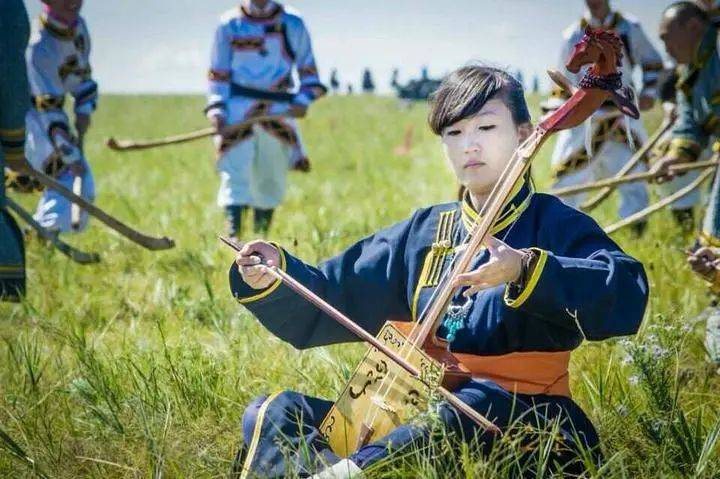Excavating the Lost Matouqin Works
In the long history, many works of Matouqin have been scattered all over the world for various reasons. The Inner Mongolia Culture Audiovisual Publishing House has collected and sorted out these scattered and lost Matouqin works, and recently published "Hundred Years of Songs - A Collection of Contemporary Matouqin's Anecdotes", which includes Sangduyin, Brin, Baier, Darima, Li Bo, Qingle and other dozens of contemporary Chinese Matouqin artists have created 100 Matouqin artworks with the characteristics of the times since the founding of New China, expanding the Matouqin repertoire library, and studying the evolution and inheritance of Matouqin repertoire creation styles and techniques important information.

Sang Du is still the founder of contemporary matouqin art. He died young at the age of 41 (1967). Many of his works have not been systematically passed down to his apprentices, so many of Sang Du's works have not entered the current repertoire library. Today, the inheritance and teaching of Matouqin still retains the inheritance model based on oral and heart teaching. The breakage, deviation of the inheritance chain, or the intersection and fusion of inheritance lineages will cause the scattered works of Matouqin. In the era of relatively closed information exchange, the dissemination of Matouqin's works was also limited and it was difficult to spread widely.
In addition to the scattered anecdotes caused by the limited inheritance and dissemination, with the changes of the times, a large number of Matouqin works with distinctive characteristics of the times and the imprint of the times have gradually disappeared from people's vision. For example, in 1975, based on the background of "Husbandry Learning from Dazhai", the Matouqin solo "Grassland Blooms in Dazhai" was composed by the composer Morjihu and played by the Matouqin player Xi Rimo; Dazhai Wushenzhao" as the creative background, "Wushenzhao New Song" composed and performed by Matouqin performer Qi Baoligao; in 1976, in commemoration of the death of Premier Zhou Enlai as the creative background, Matouqin performer Bulin composed and performed "Deep Missing" and other works, only the precious audio and video materials at that time are left, which are ignored by today's young performers.
"The artistic value of these excellent musical works should not be lost in the long history, and we urgently need to excavate and sort them out." Dr. Zhang Jinsheng of the Intangible Cultural Heritage Protection Center of Inner Mongolia selected Matouqin Sanyi's works from the three dimensions of time, space and characters, and edited and published them. "One Hundred Years of Songs - A Collection of Contemporary Matouqin's Anecdotes", including "Reminiscence - Brin Album", "Pentium - Baier Album", "Prairie Moonlight - Qingler Album", "The Legend of Matouqin - Li Bo" Album", "Spring in Ordos (31.200, 0.00, 0.00%) - Sangdu Still Album", "The Herdsmen on the Prairie Look to Beijing - Darima Album", "The Pasture Morning Song - Wulan Mu's Horse Riding Touqin Collection" " Songs in the Heart - Compilation of Matouqin Players", "Dazhai Flowers Blooming in the Grassland - Composer Matouqin Collection", "Mongolian Horses - Mongolian Horse Theme Matouqin Works Collection", etc., each with ten pieces.
In the dimension of time, the time starting point of the collection is determined after the founding of New China, with the music creation of Matouqin artists represented by Sang Du Ying et al as the starting point. The Matouqin solo "Mongolian Minor", which was adapted and composed by Sangdu in 1955 with the theme of the Xilingol folk music "Aqitu Tegusi", is regarded as the first Matouqin composition in my country. In the early 1960s and 1970s, the creation of Matouqin music gradually accumulated its own characteristics, and Matouqin music works such as "Qingsong" with the characteristics of the times, national characteristics and regional characteristics appeared. In terms of space, the collection includes all the works of contemporary Matouqin artists from Hulunbuir in the east and Alxa in the west, so as to reflect the whole picture of the evolution of the creation and performance style of contemporary Matouqin music works in my country.
In the dimension of characters, the selection of contemporary Matouqin artists is defined as a Matouqin artist who has achieved consensus in the industry and has been recognized in terms of artistic attainments and artistic contributions. These composers and performers cover dozens of representative contemporary Matouqin artists from all over the Inner Mongolia Autonomous Region since the founding of New China, showing the local customs and national features of the northern part of the motherland, as well as the ever-changing development and changes and the struggle and enterprising spirit. Spirit.
During the compilation of "Hundred Years of Songs - A Collection of Contemporary Matouqin Sanyi Works", Dr. Ge Lina of the Inner Mongolia Autonomous Region Art Research Institute took the lead in re-noting and arranging piano accompaniment for some of the songs, perfecting the three-dimensional music data, so that it has The basis of "activating practice"; Zhang Jinsheng took the lead to conduct a brief musical analysis and cultural interpretation of each Sanyi work, to determine its historical status in Mongolian music creation, the cultural symbols at that time and its influence on the creation of modern Matouqin music works and other information. After the collection of works is published, the editorial committee will also write short biographies for each matouqin artist in the collection, write personal biographies for key matouqin artists, and improve the matouqin inheritance genealogy and art history materials.
 渝公网安备 50010702504639号
渝公网安备 50010702504639号